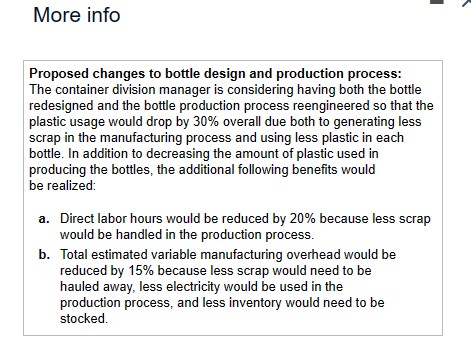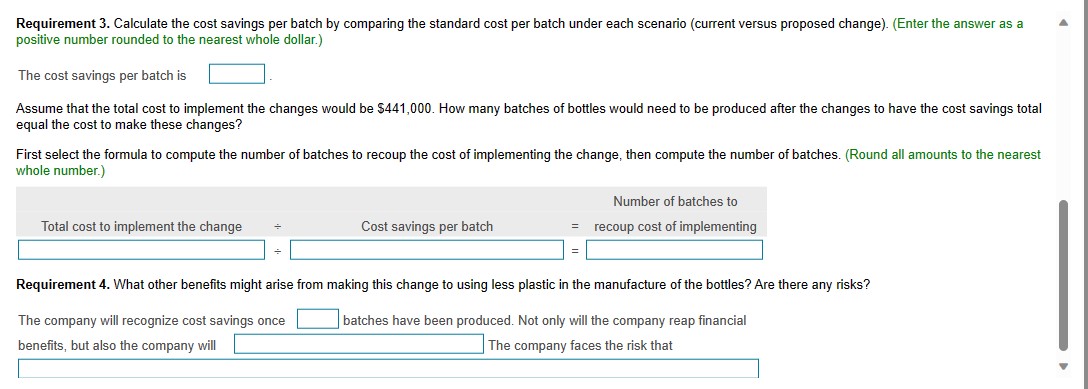Answered step by step
Verified Expert Solution
Question
1 Approved Answer
Current bottle production information: The cost and time standards per batch of 10,000 bottles are as follows: Requirement 3. Calculate the cost savings per batch





 Current bottle production information: The cost and time standards per batch of 10,000 bottles are as follows: Requirement 3. Calculate the cost savings per batch by comparing the standard cost per batch under each scenario (current versus proposed change). (Enter the answer as a positive number rounded to the nearest whole dollar.) The cost savings per batch is Assume that the total cost to implement the changes would be $441,000. How many batches of bottles would need to be produced after the changes to have the cost savings total equal the cost to make these changes? First select the formula to compute the number of batches to recoup the cost of implementing the change, then compute the number of batches. (Round all amounts to the nearest whole number.) Requirement 4 . What other benefits might arise from making this change to using less plastic in the manufacture of the bottles? Are there any risks? The company will recognize cost savings once batches have been produced. Not only will the company reap financial benefits, but also the company will The company faces the risk that Requirement 1. Calculate the standard cost per batch of 10,000 bottles using the current data (before the company makes any changes). Include direct materials, direct labor, and variable manufacturing overhead (MOH) in the standard cost per unit. Requirement 2. Calculate the standard cost per batch of 10,000 bottles if the company makes the changes to the bottle design and production process so that less plastic is used. Include direct materials, direct labor, and variable manufacturing overhead in the standard cost per unit. (Round interim calculations to two decimal places and the final answers to the nearest whole dollar.) More info Proposed changes to bottle design and production process: The container division manager is considering having both the bottle redesigned and the bottle production process reengineered so that the plastic usage would drop by 30% overall due both to generating less scrap in the manufacturing process and using less plastic in each bottle. In addition to decreasing the amount of plastic used in producing the bottles, the additional following benefits would be realized: a. Direct labor hours would be reduced by 20% because less scrap would be handled in the production process. b. Total estimated variable manufacturing overhead would be reduced by 15% because less scrap would need to be hauled away, less electricity would be used in the production process, and less inventory would need to be stocked. Warner Containers currently uses a recycled plastic to make bottles for the food industry. (Click the icon to view the current bottle production information) The variable manufacturing overhead rate is based on total estimated variable manufacturing overhead of $600,000 and estimated total DLH of 10,000 . Warner allocates its variable manufacturing overhead based on direct labor hours (DLH). (Click the icon to view the proposed changes to bottle design and production process.) Read the requirements
Current bottle production information: The cost and time standards per batch of 10,000 bottles are as follows: Requirement 3. Calculate the cost savings per batch by comparing the standard cost per batch under each scenario (current versus proposed change). (Enter the answer as a positive number rounded to the nearest whole dollar.) The cost savings per batch is Assume that the total cost to implement the changes would be $441,000. How many batches of bottles would need to be produced after the changes to have the cost savings total equal the cost to make these changes? First select the formula to compute the number of batches to recoup the cost of implementing the change, then compute the number of batches. (Round all amounts to the nearest whole number.) Requirement 4 . What other benefits might arise from making this change to using less plastic in the manufacture of the bottles? Are there any risks? The company will recognize cost savings once batches have been produced. Not only will the company reap financial benefits, but also the company will The company faces the risk that Requirement 1. Calculate the standard cost per batch of 10,000 bottles using the current data (before the company makes any changes). Include direct materials, direct labor, and variable manufacturing overhead (MOH) in the standard cost per unit. Requirement 2. Calculate the standard cost per batch of 10,000 bottles if the company makes the changes to the bottle design and production process so that less plastic is used. Include direct materials, direct labor, and variable manufacturing overhead in the standard cost per unit. (Round interim calculations to two decimal places and the final answers to the nearest whole dollar.) More info Proposed changes to bottle design and production process: The container division manager is considering having both the bottle redesigned and the bottle production process reengineered so that the plastic usage would drop by 30% overall due both to generating less scrap in the manufacturing process and using less plastic in each bottle. In addition to decreasing the amount of plastic used in producing the bottles, the additional following benefits would be realized: a. Direct labor hours would be reduced by 20% because less scrap would be handled in the production process. b. Total estimated variable manufacturing overhead would be reduced by 15% because less scrap would need to be hauled away, less electricity would be used in the production process, and less inventory would need to be stocked. Warner Containers currently uses a recycled plastic to make bottles for the food industry. (Click the icon to view the current bottle production information) The variable manufacturing overhead rate is based on total estimated variable manufacturing overhead of $600,000 and estimated total DLH of 10,000 . Warner allocates its variable manufacturing overhead based on direct labor hours (DLH). (Click the icon to view the proposed changes to bottle design and production process.) Read the requirements Step by Step Solution
There are 3 Steps involved in it
Step: 1

Get Instant Access to Expert-Tailored Solutions
See step-by-step solutions with expert insights and AI powered tools for academic success
Step: 2

Step: 3

Ace Your Homework with AI
Get the answers you need in no time with our AI-driven, step-by-step assistance
Get Started


